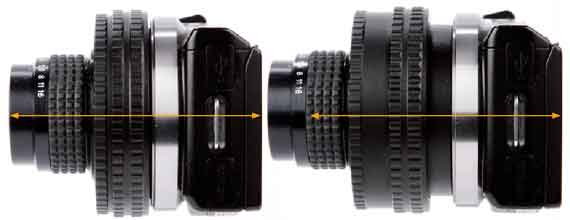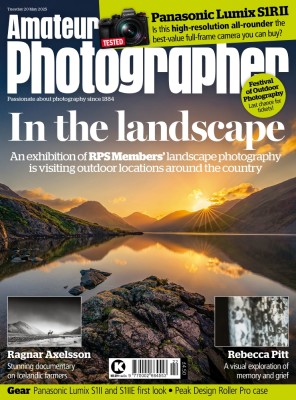Enlarger lenses are among the simplest of optics. With no internal focusing mechanism, their design is very straightforward – some have only four aperture blades. This simplicity, and the lack of demand for them, means they are currently extremely cheap to buy. A quick search online shows that you can get hold of one for as little as £5, but generally most range in price from £20-£40.
However, enlarger lenses were never intended for use in capturing an image, so there are some issues that must be overcome if you are to do so.
Why use an enlarger lens?
Designed as they are to project a flat piece of film onto the flat surface of photographic paper, enlarger lenses show virtually no curvilinear distortion. This is why they are generally standard lenses: 50mm for 35mm film, or 80mm for medium-format film.
Edge-to-edge sharpness is also important when printing and, again, enlarger lenses must perform well in this regard. Vignetting is also a consideration at the edges of printed images, as the whole print must receive as close to an even exposure as possible. Therefore, enlarger lenses will have a minimum aperture of only f/4, or even f/5.6, which helps to avoid vignetting.
Like any other optics, there are certain enlarger lenses that perform well in all of the above, while others aren’t quite up to scratch. However, by learning the qualities of a specific lens, you can exploit it to take some stunning images.
The Basics
The vast majority of enlarger lenses have a 39mm screw thread. This thread is nearly identical to the M39 screw thread used by Leica and other manufacturers for their early rangefinder cameras. As such, it is possible to mount enlarger lenses onto M39 thread-mount cameras, and this means it is also possible to mount them to modern compact system cameras via a M39 adapter.
The problem is that the lenses have no means of focus. When used on an enlarger, they have the ability to focus back and forth by using a bellows. When on a camera, to focus an enlarger lens at different distances requires some back and forth movement.


Taken using the enlarger lens and bellows pictured right, these macro shots are of a dragonfly larva’s shedded exoskeleton
Helicoid Focusing Adapters
A helicoid is a circular spiral mechanism that extends backwards and forwards when turned. The most obvious example of this is the movement of a lens barrel back and forth when a focus or zoom ring is turned.
Like any other lens adapter, these have a camera mount on one side and a lens mount the other. Twisting the helicoid mechanism will move the lens back and forth, and thus change the position of the focus.
Most of the time, helicoid adapters are used for macro focusing. In effect, the helicoids become an adjustable macro extension tube, moving the lens back and forth to give the required level of magnification.
When used with an M39 screw thread, the helicoids can be used with an enlarger lens, and the lens used as if it were a normal optic. Simply set the required aperture and use the helicoid’s adapter to focus the lens back and forth. Depending on the size of the helicoid and the exact lens being used, it should be possible to focus to infinity.
The drawback here is the availability of these adapters. You won’t often find them on the shelves of photographic retailers, so the internet and eBay are the best bets.

The helicoid adapter moves the enlarger lens back and forth to enable it to focus. This will only work on a compact system camera as the flange depth is short enough for it to focus. On a DSLR system, it will act more like an adjustable extension tube for macro images

Like any other type of photographic lens, enlarger lenses can vary tremendously in price. Cheap lenses may have square aperture blades, which can create interesting effects
Using a Bellows
The most logical way to get an enlarger lens to focus when using it on a camera is to replicate the bellows of an enlarger using a set of macro bellows. Mount one end of these bellows to the camera, and the other to an M39 mount to allow enlarger lenses to be used. Some bellows, such as the old, but very popular BPM Universal bellows, or the Novoflex Universal BALPRO 1 (www.novoflex.com/en/products/macro-accessories/bellows-systems/universal-bellows) allow various combinations of lenses. For example, an M39 mount can be connected to the front of the bellows and a Nikon F mount to the rear, to allow enlarger lenses to be used on a Nikon camera.
At the very short extensions of the bellows, an enlarger lens may just about be able to focus on infinity using a compact system camera, but the larger flange depth means that infinity won’t be available on a DSLR. Instead, the enlarger lens will only be able to focus at very close distances on a DSLR. Also, by extending the bellows on a DSLR or a compact system camera, the enlarger lens will make an excellent macro optic.
Handholding
The simplest, but least exact, method of using an enlarger lens is to shoot handheld. With no lens mounted on the camera, wrap the enlarger lens in your hand and press it up against the camera mount. Moving your hand back and forth, it should be possible to roughly focus the lens.
It is extremely hard to hold the lens in the correct position to focus, and consequently images will tend to be soft. Similarly, it is difficult to match the horizontal plane of the film and sensor, so there will usually also be a slight tilt-and-shift effect, often with quite a narrow focal plane.
Despite the obvious flaws in shooting handheld, this method can produce some striking images – unique, too, given that it is so difficult to take exactly the same image twice.








